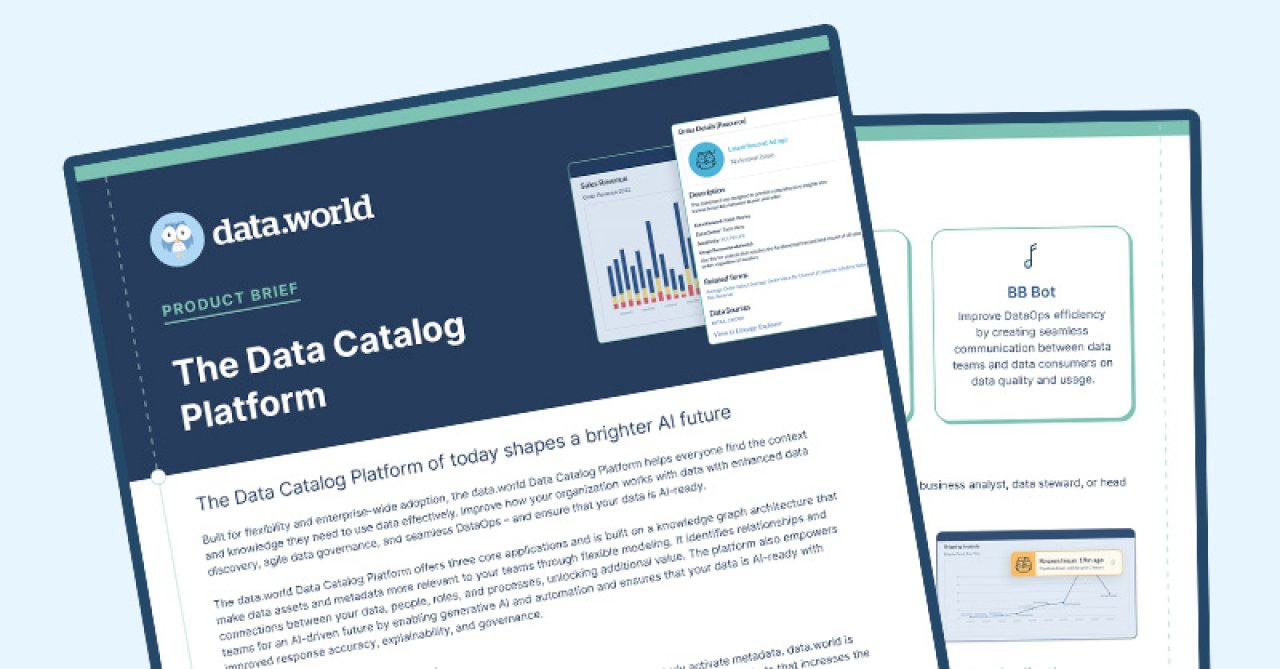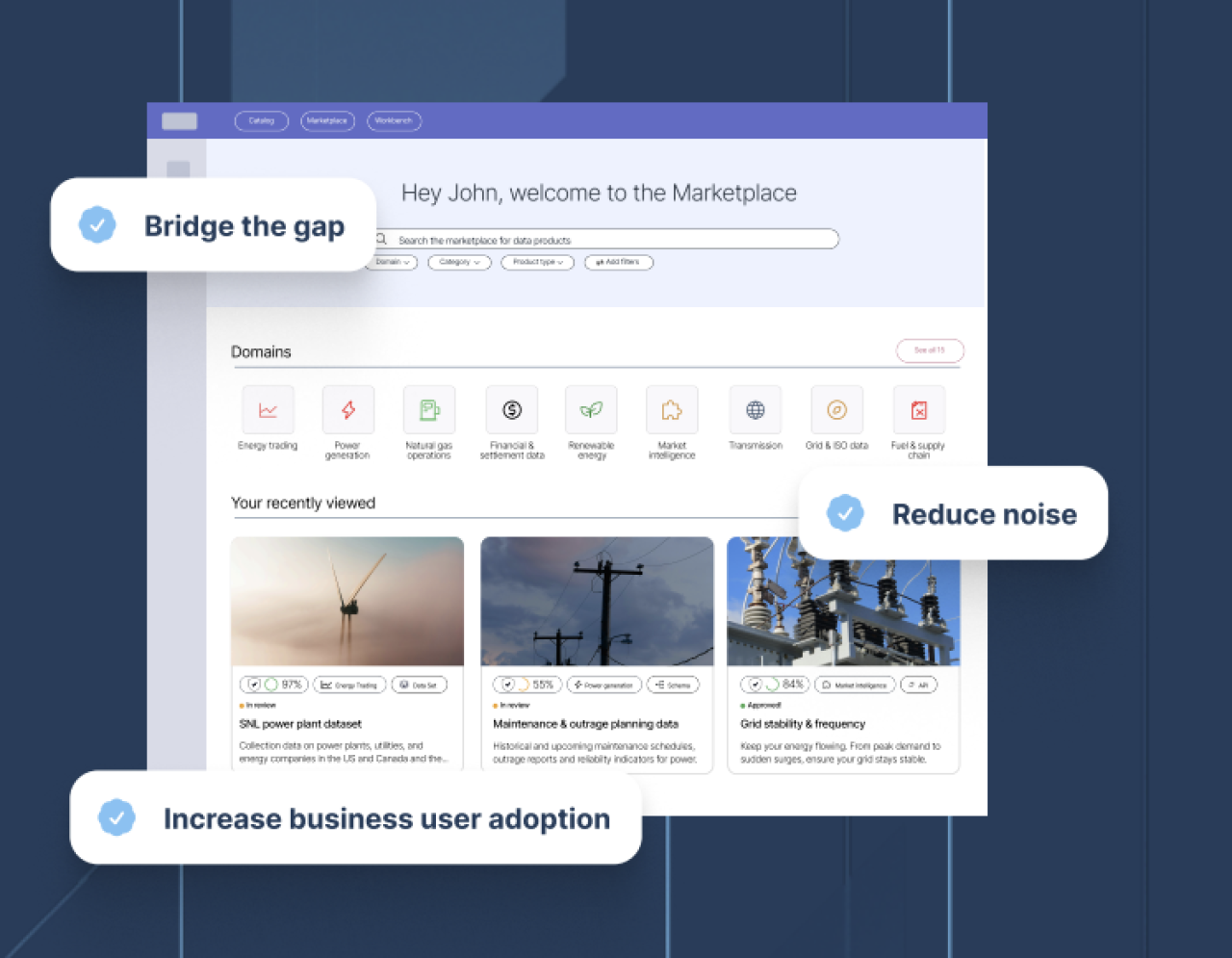







Jun 04, 2025
Daniel Herman

Picture this: You walk into IKEA and immediately face two choices. You could head straight to the warehouse—navigating endless aisles of flat-packed furniture organized by product codes and technical specifications. Or you could start in the showroom, where complete room setups show you exactly how that bookshelf looks in a real living space, complete with styling tips and everything you need to recreate the look at home.
Most people choose the showroom. And now, your data users can too.
Here's a reality check: 73% of enterprise data goes unused for analytics. Why? Because finding the right data feels like searching for a needle in a haystack—except the haystack keeps growing, and you're not even sure what the needle looks like.
Your data catalog might contain thousands of datasets, but that doesn't mean your business users can find what they need. Sales managers don't want to dig through technical schemas to find customer retention metrics. Marketing analysts shouldn't need to understand ETL pipelines to access campaign performance data. Finance leaders don't have time to parse through data lineage diagrams when they need quarterly revenue insights.
The traditional catalog serves data teams brilliantly—it's the warehouse where everything lives. But business users need something different. They need the showroom.
Introducing Data Marketplace: Where Data Meets Business Value
Today, we're excited to introduce Data Marketplace—a purpose-built, e-commerce-style discovery experience that transforms how business users find and access your organization's most valuable data products.
Think of it as your catalog's business-friendly front door. While your full catalog remains the comprehensive warehouse of all your data assets, Data Marketplace curates and showcases only your highest-quality, most trusted data products in a familiar, shopping-like experience.
Data Marketplace organizes your data products around business domains and use cases, not technical structures. Instead of browsing by database schema, users explore by:
Customer analytics
Financial reporting
Marketing performance
Supply chain optimization
Each data product comes with visual merchandising, clear descriptions, and business-relevant metadata that helps users quickly identify what they need.
The familiar e-commerce interface removes barriers to data adoption. Business users get:
Consumer-grade UX with visual browsing and intuitive navigation
Personalized landing pages with suggested content based on their role and history
Simplified access workflows that don't require deep technical knowledge
Clear data contracts that explain what each data product delivers
Data Marketplace doesn't just make data easier to find—it makes your data investments more valuable:
Promotes your best assets: Only curated, high-quality data products appear in the marketplace
Supports data mesh architectures: Enables domain-oriented data product management
Drives cross-domain collaboration: Makes it easy to discover relevant data products across business units
Future-proofs your strategy: Aligns with emerging industry practices around data products and domain-oriented data management
Consider how Data Marketplace transforms these common scenarios:
Before: A marketing analyst spends hours asking colleagues which datasets contain customer engagement metrics, then struggles to understand technical field names and data quality issues.
After: They browse the "Marketing Performance" domain in Data Marketplace, find a certified "Customer Engagement Metrics" data product with clear business definitions, sample queries, and quality indicators—all in under five minutes.
Before: A finance team manually rebuilds the same revenue calculations every quarter because they can't easily find or trust existing datasets.
After: They subscribe to a "Quarterly Revenue Analytics" data product that's maintained by the finance data team, automatically updated, and includes all the context they need for board presentations.
Data Marketplace isn't a separate system—it's a new lens on your existing catalog. Data products are created and managed in your familiar catalog environment, then published to the marketplace with a simple status change. This means:
No data duplication or maintenance overhead
Same governance and security as your existing catalog
Easy transitions between marketplace and catalog views
Leverages existing investments in metadata and documentation
Rolling out Data Marketplace is designed to be straightforward:
Identify your star products: Start with your most trusted, well-documented, and frequently used data assets
Organize by business domains: Structure around business functions rather than technical systems
Publish and promote: Transform selected catalog assets into marketplace-ready data products
Enable self-service: Let business users discover and access what they need
Data Marketplace represents a fundamental shift in how organizations think about data accessibility. Instead of expecting business users to become data engineers, we're making data behave like the consumer products they're already comfortable with.
This isn't just about a new interface—it's about recognizing that different users need different experiences. Your data engineers will always need the full technical depth of the catalog. But your business users need something that speaks their language and serves their workflows.
Data Marketplace will be available for private preview by the end of June 2025, with public preview following in August. If you're ready to move from data documentation to data promotion—from warehouse to showroom—we'd love to show you what's possible.
The future of data discovery isn't about building bigger warehouses. It's about creating better showrooms.
Ready to see how it works? Schedule a demo to explore the showroom experience for yourself.

Picture this: You walk into IKEA and immediately face two choices. You could head straight to the warehouse—navigating endless aisles of flat-packed furniture organized by product codes and technical specifications. Or you could start in the showroom, where complete room setups show you exactly how that bookshelf looks in a real living space, complete with styling tips and everything you need to recreate the look at home.
Most people choose the showroom. And now, your data users can too.
Here's a reality check: 73% of enterprise data goes unused for analytics. Why? Because finding the right data feels like searching for a needle in a haystack—except the haystack keeps growing, and you're not even sure what the needle looks like.
Your data catalog might contain thousands of datasets, but that doesn't mean your business users can find what they need. Sales managers don't want to dig through technical schemas to find customer retention metrics. Marketing analysts shouldn't need to understand ETL pipelines to access campaign performance data. Finance leaders don't have time to parse through data lineage diagrams when they need quarterly revenue insights.
The traditional catalog serves data teams brilliantly—it's the warehouse where everything lives. But business users need something different. They need the showroom.
Introducing Data Marketplace: Where Data Meets Business Value
Today, we're excited to introduce Data Marketplace—a purpose-built, e-commerce-style discovery experience that transforms how business users find and access your organization's most valuable data products.
Think of it as your catalog's business-friendly front door. While your full catalog remains the comprehensive warehouse of all your data assets, Data Marketplace curates and showcases only your highest-quality, most trusted data products in a familiar, shopping-like experience.
Data Marketplace organizes your data products around business domains and use cases, not technical structures. Instead of browsing by database schema, users explore by:
Customer analytics
Financial reporting
Marketing performance
Supply chain optimization
Each data product comes with visual merchandising, clear descriptions, and business-relevant metadata that helps users quickly identify what they need.
The familiar e-commerce interface removes barriers to data adoption. Business users get:
Consumer-grade UX with visual browsing and intuitive navigation
Personalized landing pages with suggested content based on their role and history
Simplified access workflows that don't require deep technical knowledge
Clear data contracts that explain what each data product delivers
Data Marketplace doesn't just make data easier to find—it makes your data investments more valuable:
Promotes your best assets: Only curated, high-quality data products appear in the marketplace
Supports data mesh architectures: Enables domain-oriented data product management
Drives cross-domain collaboration: Makes it easy to discover relevant data products across business units
Future-proofs your strategy: Aligns with emerging industry practices around data products and domain-oriented data management
Consider how Data Marketplace transforms these common scenarios:
Before: A marketing analyst spends hours asking colleagues which datasets contain customer engagement metrics, then struggles to understand technical field names and data quality issues.
After: They browse the "Marketing Performance" domain in Data Marketplace, find a certified "Customer Engagement Metrics" data product with clear business definitions, sample queries, and quality indicators—all in under five minutes.
Before: A finance team manually rebuilds the same revenue calculations every quarter because they can't easily find or trust existing datasets.
After: They subscribe to a "Quarterly Revenue Analytics" data product that's maintained by the finance data team, automatically updated, and includes all the context they need for board presentations.
Data Marketplace isn't a separate system—it's a new lens on your existing catalog. Data products are created and managed in your familiar catalog environment, then published to the marketplace with a simple status change. This means:
No data duplication or maintenance overhead
Same governance and security as your existing catalog
Easy transitions between marketplace and catalog views
Leverages existing investments in metadata and documentation
Rolling out Data Marketplace is designed to be straightforward:
Identify your star products: Start with your most trusted, well-documented, and frequently used data assets
Organize by business domains: Structure around business functions rather than technical systems
Publish and promote: Transform selected catalog assets into marketplace-ready data products
Enable self-service: Let business users discover and access what they need
Data Marketplace represents a fundamental shift in how organizations think about data accessibility. Instead of expecting business users to become data engineers, we're making data behave like the consumer products they're already comfortable with.
This isn't just about a new interface—it's about recognizing that different users need different experiences. Your data engineers will always need the full technical depth of the catalog. But your business users need something that speaks their language and serves their workflows.
Data Marketplace will be available for private preview by the end of June 2025, with public preview following in August. If you're ready to move from data documentation to data promotion—from warehouse to showroom—we'd love to show you what's possible.
The future of data discovery isn't about building bigger warehouses. It's about creating better showrooms.
Ready to see how it works? Schedule a demo to explore the showroom experience for yourself.